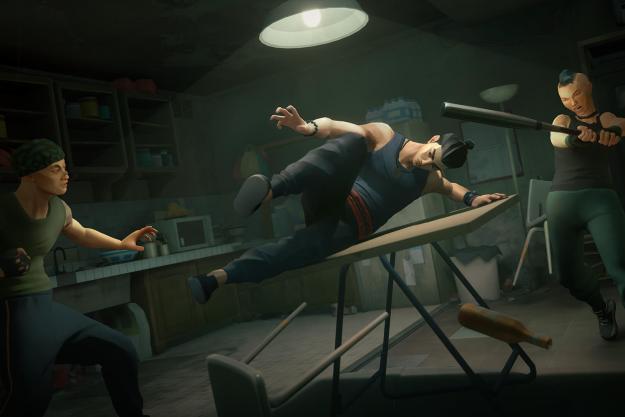
“A rewarding experience from its start, Sifu delivers challenge after challenge, all of which are too exciting to turn down.”
- Wealth of attacks
- Brilliantly stylish combat
- Gorgeous visuals
- Satisfying progression
- Intense boss battles
- Somewhat repetitive
- Extremely difficult
Throughout my time playing Sifu, one phrase kept going through my mind. “You can do better,” I told myself as I was knocked out by a boss for the umpteenth time. Or when I was smacked down by a simple enemy. Or when I was hit by someone that I had previously taken out without a scratch. Improvement was always on my mind.
Self-betterment is one of Sifu‘s many themes, along with revenge and forgiveness, but it’s the only one that ties both the game’s narrative and gameplay together. Not only is the main character’s journey over the course of the game about them growing into a Kung Fu master, but you, the player, will have to improve as well.
Sifu is a madly challenging game, pitting players against five bosses that they have to beat over the course of one lifespan, using 70 years’ worth of time in one night thanks to a magic talisman. And while that difficulty is almost always offset by the game’s immensely satisfying combat mechanics and its addictive progression system, being a Kung Fu master can get exhausting.
For some, the challenge that Sifu presents won’t be worth it, as they spiral into a loop of dying and getting back up. But anyone who ever thought Dark Souls would be better without its bonfires is going to find a masterpiece in balancing difficult yet rewarding gameplay.
Grow up
Easily the most divisive part of Sifu is the game’s aging mechanic. Players fill the shoes of a young, 20-year-old martial artist looking to avenge their former master, who was murdered by a group of five Kung-Fu masters. In the game, all of these fights take place over the course of one night, but for the main character, it may be years until their master is avenged.
Every time the hero goes down in Sifu, they can get back up thanks to a magic talisman they wear. However, they won’t be the same after coming back from the grave. Instead, some time is taken away from them, and they get up older. The more players die, the older they get every time they come back. This isn’t too bad, except dying more means coming back exponentially older.
The character’s age in Sifu increases by whatever number the game’s “death counter” is on. Increasing every time players go down, the game can quickly spiral into a cycle of dying, growing older, getting up, and dying again. It certainly doesn’t help that with every decade, players have less health. Their character will also do more damage to enemies, as they’re an older and wiser Kung Fu master, but it won’t matter much if punches and kicks aren’t avoided.

One of Sifu‘s many goals is to stay as young as possible over the course of the game’s five levels, a massive challenge in and of itself. Each stage, all of which are a treat to fight through, is packed with enemies. They range in difficulty, with some basic grunts going down in a few hits while other trained fighters can block attacks and have to be approached thoughtfully. The game does its players a favor by granting a bit of health back after an enemy is taken down, but that doesn’t matter much when it comes to boss fights.
Sifu‘s bosses are some of the most difficult boss fights I’ve encountered in any game. They’re also the most fun. Each of Sifu‘s bosses has its own style, attacks, and personality. The game’s first boss attacks wildly, eventually slicing away at players with a machete, while the third starts by using a graceful weapon made of knives tied to chains but soon after drops those for a pair of kunai.
The game is merciless, but the reward for solving its combat puzzles is immense.
However, each boss has its weaknesses. Some are vulnerable after a certain attack, others have moves that can be parried. Every attack can be dodged, leaving bosses open to a counter afterward. While your character gets older and wiser in Sifu, you have to as well. The game isn’t forgiving in this; you won’t be able to brute-force any of its bosses. In fact, it’s extremely likely that the game’s first boss will beat you.
That’s ok, though. The first time I beat the game’s first boss, I had hit age 70. I couldn’t continue the game, so I decided to start over. Taking what I had learned from our first fight, I was able to beat the first boss again, only hitting age 30. Two more attempts later and I could beat the first stage without dying once.

In the same way as Sifu‘s main character grows up, it demands players do as well. The game won’t hold your hand, and it certainly won’t offer any room to breathe. Instead, it throws players into a difficult fight, telling them to grow up and figure it out. The game is merciless, but the reward for solving its combat puzzles is immense. Figuring out what works when and where attacks fit means players can become ruthlessly efficient, matching Sifu‘s revenge-fueled character.
Do better
In more ways than one, the “you can do better” mantra of self-improvement is central to the overall game. Repetition and memorization are both keys to playing successfully, but to beat the game itself, players will have to improve in just about every way.
Thankfully, Sifu offers ways for players to do that without losing all of their progress. The game isn’t a full-on roguelike, with its structure having more in common with Dark Souls than Hades. Players can unlock skills that diversify the game’s combat at shrines scattered across levels or any time they die. After being purchased with experience points, skills can then be permanently unlocked for even more XP, granting huge boosts to a player’s arsenal.
Unlocking those skills requires a lot of XP though, and that means running through levels you’ve already completed multiple times just to grind out that next attack you want. It’s a double-edged part of the game’s design since levels do eventually get repetitive to run through. They never change, and despite constantly being pretty to look at, fighting the same groups of enemies over and over again through each level can get tiring. Shortcuts can eventually be unlocked for all of the game’s levels, giving players a more direct route to each boss. They’re not always easy to find though, and the keys for some early-game shortcuts are only available in Sifu‘s later levels.

For most of the time that I played the game though, I didn’t find that this repetition was tiring. Instead, Sifu‘s stellar combat carried it during what would have been tedious moments for any other game. Fights in the game never unfold the same way, with enemies always attacking differently than they had before. Combat throughout the game isn’t wholly active or reactive, it’s a mixture of both, making each battle dynamic, whether it’s between the player and one enemy or a dozen.
Mastering Sifu‘s combat means you’ll be able to dictate the entire flow of battles. By the end of my time with the game, I knew how to force an enemy away from me, sweep the legs of another, and take down one final grunt with a flurry of attacks. And by using every attack available, fights become an action-packed blast to watch.
Sifu‘s stellar combat carried it during what would have been tedious moments for any other game.
But that’s the rub: The game’s combat is something that has to be mastered. At first, it’s easy to get away with mashing the square or triangle buttons to hurt an enemy, then pressing another two to carry out a scripted take-down. However, that strategy won’t carry anyone throughout the whole game. To beat Sifu, players have to use every tool at their disposal, something that’s especially true of the game’s final boss. That includes the game’s environments themselves, which are packed with both practical and improvised weapons, and walls to hurl enemies against.

Sifu isn’t a flexible game, in that it only really gives players one way to play. Sure, you can focus on using weapons as much as possible, but rarely will they always be available. Most of the time, all players have to defend themselves with are their hands and feet, and they have to be used perfectly. Sifu is a demanding game, one that rewards players who adhere to it with an unbeatable experience.
Beating a boss without dying is one thing, but continuing on that streak is another entirely. It’s a goal, something that the game clearly wants its players to work towards. You’re not supposed to die in Sifu, and the game treats its aging mechanic as a bit of forgiveness for that mistake. Instead, it wants its players to complete the game without a single misstep, and with that goal in mind, every fight becomes all the more thrilling.
Our take
Sifu‘s punishing loop and intense combat are nothing short of brilliant. It’s one of those rare titles that doesn’t just want players to do their best; it demands it instead. Falling short of that requirement means the entire experience is going to be that much harder until you start doing better. For a majority of people, that’s not going to translate to a fun gameplay experience, but it perfectly serves the game’s themes. Through time, practice, and repetition though, challenging fights become easy. Bosses that seemed impossible to touch turn vulnerable at every moment. You start to see the game in a different light, the same way a trained martial artist approaches situations differently from any average brawler. If you follow Sifu‘s training, it has the potential to be one of this year’s best titles.
Is there a better alternative?
No. Sifu is the peak of modern action-adventure fighting games, with nothing else on the market coming close.
How long will it last?
Beating Sifu can take around 25 hours, but getting the game’s true ending and picking up all of its collectibles can easily extend its playtime to 40 hours.
Should you buy it?
Yes. Sifu isn’t going to be for everyone, but anyone who likes games and isn’t afraid of a challenge should at the very least buy it and give it a try.
Sifu was tested with a PlayStation 5 and an Insignia F30 4K Smart TV.
Editors' Recommendations
- Hollow Knight: Silksong: release date speculation, trailers, gameplay, and more
- Day of the Devs brings surprising sequels, a truffle pig RPG, and more must-see games
- Sludge Life is getting a surprising sequel and we’ve already tried it
- Cursed to Golf beginner’s guide: 8 tips and tricks
- Slime Rancher 2 beginner’s guide: 12 tips and tricks




